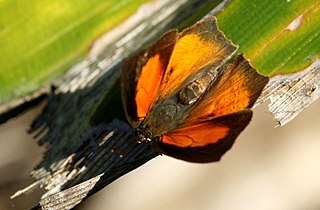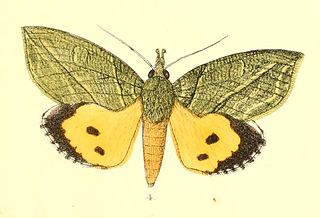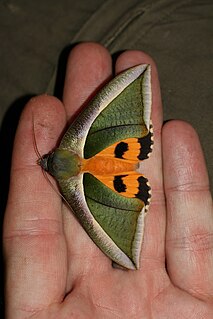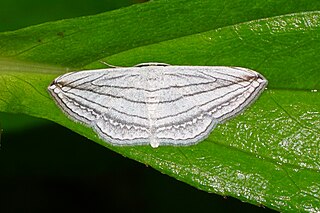
Curetis acuta, the angled sunbeam, is a species of butterfly belong to the lycaenid family. It is found in Indomalayan realm.

Arsacia is a monotypic moth genus of the family Noctuidae. Its only species is Arsacia rectalis. Both the genus and species were described by Francis Walker, the genus in 1866 and the species in 1863. It is found from the Indo-Australian tropics of India, Sri Lanka to Queensland and the Solomon Islands.

Hulodes caranea is a species of moth of the family Erebidae first described by Pieter Cramer in 1780. It is found from India, Sri Lanka, Myanmar, Java, Hong Kong to Queensland and New Guinea, it is also found on the Marianas and Carolines.

Pindara illibata is a moth of the family Noctuidae first described by Johan Christian Fabricius in 1775. It is found in the Oriental region, including Taiwan, China, India, Sri Lanka, Myanmar, Japan and Borneo.

Eudocima homaena is a moth of the family Erebidae first described by Jacob Hübner in 1816. It is found in the Indian subregion, Sri Lanka, Taiwan, the Nicobars, Peninsular Malaysia, Borneo, the Philippines and on Christmas Island. It is a major pest on orange plants.

Eudocima hypermnestra is a moth of the family Erebidae described by Pieter Cramer in 1780. It is found in China, Thailand, Taiwan, India and Sri Lanka.

Eudocima salaminia, the green fruit-piercing moth, is a moth of the family Erebidae. The species was first described by Pieter Cramer in 1777. It is found from India, and across south-east Asia to the Pacific Islands. In Australia it occurs in the Northern Territory, Queensland and New South Wales. The adult is a fruit piercer.

Chiasmia emersaria is a moth of the family Geometridae. The species was first described by Francis Walker in 1861. It is found in India, Nepal, northern Thailand, China, Sri Lanka, Japan and the Ryukyu Islands.

Urapteroides astheniata is a moth of the family Uraniidae first described by Achille Guenée in 1857. It is found in south-east Asia, from India, Sri Lanka to Fiji, including New Guinea and the tropical north of Australia.

Leucophlebia lineata, the large candy-striped hawkmoth, is a moth of the family Sphingidae. It was described by John O. Westwood in 1847. It is known from Sri Lanka, India, Nepal, Thailand, eastern and southern China, Taiwan, Cambodia, Vietnam, Malaysia, Indonesia and the Philippines. It is a minor pest of sugarcane.

Blasticorhinus rivulosa is a moth of the family Noctuidae. It is found in Japan, Taiwan, India and Sri Lanka.

Negeta contrariata is a moth in the family Nolidae first described by Francis Walker in 1862. It is found from the Indo-Australian tropics of India, Sri Lanka, Borneo east to Australia (Queensland) and the Bismarck Archipelago.
Scopula emissaria is a moth of the family Geometridae. It was described by Francis Walker in 1861. It is found in India, Sri Lanka, Myanmar, Vietnam, China, Korea, Japan, the Philippines, Sumatra, Java, Wallacea and Australia.

Scopula opicata is a moth of the family Geometridae. It is found in tropical Africa, including Malawi and Zambia, as well as in Sri Lanka, India, China (Hainan), Burma, Sundaland, the Philippines, Sulawesi, Timor and New Guinea.

Dysaethria quadricaudata is a species of moth of the family Uraniidae first described by Francis Walker in 1896. It is found in the Indo-Australian tropics from India, Sri Lanka to Myanmar, Taiwan and the Solomon Islands. The habitat consists of lowland forests and disturbed and cultivated areas.

Bocula pallens is a moth of the family Noctuidae first described by Frederic Moore in 1882. It is found in northern India, and Sri Lanka.
Garudinia latana is a moth of the family Erebidae first described by Francis Walker in 1863. It is found in Sri Lanka.
Acantholipes trajecta is a species of moth in the family Erebidae first described by Francis Walker in 1865. It is found in South Africa, India, Sri Lanka, and Australia, where it has been recorded from Western Australia, the Northern Territory and Queensland.

Erygia apicalis is a moth of the family Erebidae first described by Achille Guenée in 1852. It is found from the Indo-Australian tropics of India, Sri Lanka to Japan, Australia and the Solomon Islands. The habitat consists of lowland areas, including dry heath forests and softwood plantations.

Sphingomorpha chlorea, the sundowner moth, is a species of moth in the family Erebidae that is native to Africa and southern Asia. The species was first described by Pieter Cramer in 1777. It is a fruit-piercing moth and a notorious pest in orchards. The fruit is pierced while performing a vertical and rhythmic movement of the head.




















